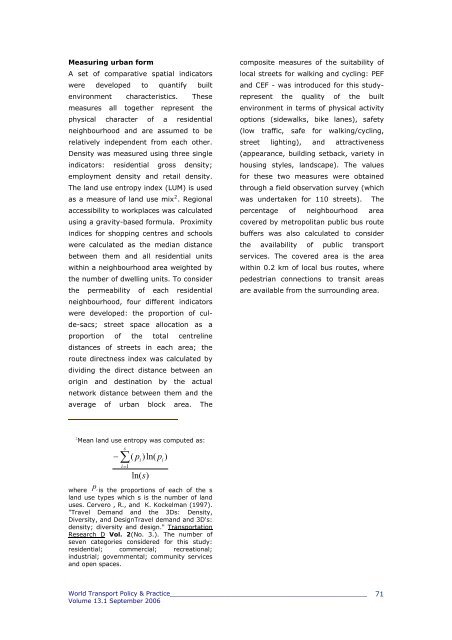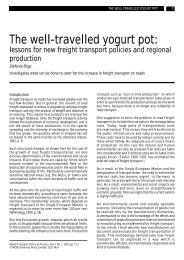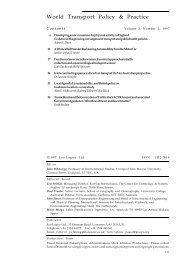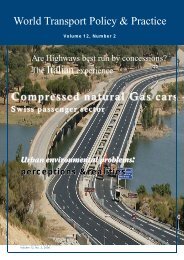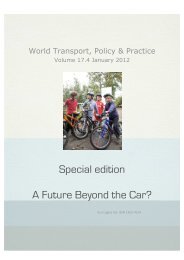Effects of pedestrianisation on the commercial and ... - Eco-Logica
Effects of pedestrianisation on the commercial and ... - Eco-Logica
Effects of pedestrianisation on the commercial and ... - Eco-Logica
Create successful ePaper yourself
Turn your PDF publications into a flip-book with our unique Google optimized e-Paper software.
Measuring urban form<br />
A set <str<strong>on</strong>g>of</str<strong>on</strong>g> comparative spatial indicators<br />
were developed to quantify built<br />
envir<strong>on</strong>ment characteristics. These<br />
measures all toge<strong>the</strong>r represent <strong>the</strong><br />
physical character <str<strong>on</strong>g>of</str<strong>on</strong>g> a residential<br />
neighbourhood <strong>and</strong> are assumed to be<br />
relatively independent from each o<strong>the</strong>r.<br />
Density was measured using three single<br />
indicators: residential gross density;<br />
employment density <strong>and</strong> retail density.<br />
The l<strong>and</strong> use entropy index (LUM) is used<br />
as a measure <str<strong>on</strong>g>of</str<strong>on</strong>g> l<strong>and</strong> use mix 2 . Regi<strong>on</strong>al<br />
accessibility to workplaces was calculated<br />
using a gravity-based formula. Proximity<br />
indices for shopping centres <strong>and</strong> schools<br />
were calculated as <strong>the</strong> median distance<br />
between <strong>the</strong>m <strong>and</strong> all residential units<br />
within a neighbourhood area weighted by<br />
<strong>the</strong> number <str<strong>on</strong>g>of</str<strong>on</strong>g> dwelling units. To c<strong>on</strong>sider<br />
<strong>the</strong> permeability <str<strong>on</strong>g>of</str<strong>on</strong>g> each residential<br />
neighbourhood, four different indicators<br />
were developed: <strong>the</strong> proporti<strong>on</strong> <str<strong>on</strong>g>of</str<strong>on</strong>g> culde-sacs;<br />
street space allocati<strong>on</strong> as a<br />
proporti<strong>on</strong> <str<strong>on</strong>g>of</str<strong>on</strong>g> <strong>the</strong> total centreline<br />
distances <str<strong>on</strong>g>of</str<strong>on</strong>g> streets in each area; <strong>the</strong><br />
route directness index was calculated by<br />
dividing <strong>the</strong> direct distance between an<br />
origin <strong>and</strong> destinati<strong>on</strong> by <strong>the</strong> actual<br />
network distance between <strong>the</strong>m <strong>and</strong> <strong>the</strong><br />
average <str<strong>on</strong>g>of</str<strong>on</strong>g> urban block area. The<br />
2<br />
Mean l<strong>and</strong> use entropy was computed as:<br />
s<br />
− ∑ ( pi<br />
) ln( pi<br />
)<br />
i=<br />
1<br />
p<br />
ln( s)<br />
where i is <strong>the</strong> proporti<strong>on</strong>s <str<strong>on</strong>g>of</str<strong>on</strong>g> each <str<strong>on</strong>g>of</str<strong>on</strong>g> <strong>the</strong> s<br />
l<strong>and</strong> use types which s is <strong>the</strong> number <str<strong>on</strong>g>of</str<strong>on</strong>g> l<strong>and</strong><br />
uses. Cervero , R., <strong>and</strong> K. Kockelman (1997).<br />
"Travel Dem<strong>and</strong> <strong>and</strong> <strong>the</strong> 3Ds: Density,<br />
Diversity, <strong>and</strong> DesignTravel dem<strong>and</strong> <strong>and</strong> 3D's:<br />
density; diversity <strong>and</strong> design." Transportati<strong>on</strong><br />
Research D Vol. 2(No. 3.). The number <str<strong>on</strong>g>of</str<strong>on</strong>g><br />
seven categories c<strong>on</strong>sidered for this study:<br />
residential; <strong>commercial</strong>; recreati<strong>on</strong>al;<br />
industrial; governmental; community services<br />
<strong>and</strong> open spaces.<br />
composite measures <str<strong>on</strong>g>of</str<strong>on</strong>g> <strong>the</strong> suitability <str<strong>on</strong>g>of</str<strong>on</strong>g><br />
local streets for walking <strong>and</strong> cycling: PEF<br />
<strong>and</strong> CEF - was introduced for this studyrepresent<br />
<strong>the</strong> quality <str<strong>on</strong>g>of</str<strong>on</strong>g> <strong>the</strong> built<br />
envir<strong>on</strong>ment in terms <str<strong>on</strong>g>of</str<strong>on</strong>g> physical activity<br />
opti<strong>on</strong>s (sidewalks, bike lanes), safety<br />
(low traffic, safe for walking/cycling,<br />
street lighting), <strong>and</strong> attractiveness<br />
(appearance, building setback, variety in<br />
housing styles, l<strong>and</strong>scape). The values<br />
for <strong>the</strong>se two measures were obtained<br />
through a field observati<strong>on</strong> survey (which<br />
was undertaken for 110 streets). The<br />
percentage <str<strong>on</strong>g>of</str<strong>on</strong>g> neighbourhood area<br />
covered by metropolitan public bus route<br />
buffers was also calculated to c<strong>on</strong>sider<br />
<strong>the</strong> availability <str<strong>on</strong>g>of</str<strong>on</strong>g> public transport<br />
services. The covered area is <strong>the</strong> area<br />
within 0.2 km <str<strong>on</strong>g>of</str<strong>on</strong>g> local bus routes, where<br />
pedestrian c<strong>on</strong>necti<strong>on</strong>s to transit areas<br />
are available from <strong>the</strong> surrounding area.<br />
World Transport Policy & Practice___________________________________________________<br />
Volume 13.1 September 2006<br />
71


